One-Way Frequency of Eye Color By Region
Overview
Use the Frequency transformations
to produce one-way to n-way frequency and contingency (crosstabulation)
tables. The Frequency transformations are based on the FREQ procedure,
which generates frequency statistics. For more information about this
procedure, see "The FREQ Procedure" section in Base SAS
Procedures Guide.
There are two Frequency
transformations: Frequency and One-Way Frequency. The Frequency transformation
uses PROC FREQ to compute statistics for complex tests, measures of
association, and stratified analysis of one-way to n-way tables. The One-Way Frequency transformation
is used for simpler PROC FREQ analysis on one-way tables to examine
the relationship between two classification variables. It can also
be used to compute statistics for equal proportions, specified proportions,
or the binomial proportion. The One-Way Frequency transformation also
has a subset of the options available for the Frequency transformation.
Both Frequency transformations
control many aspects of the analysis, including the following:
-
grouping of rows by the values in one or more columns
-
how the rows appear in the report
-
which column or columns are analyzed
You can use the Frequency transformations to generate frequency statistics in a target and on the Output tab of the Job Editor. ODS output in the form of HTML, PDF, or RTF can be sent to
a folder on the SAS Application Server that executes the job. ODS output can also be sent to any folder with access to that SAS Application Server.
The target receives data only for the source columns that are involved in the analysis. The target requires two columns that either
Frequency transformation populates: Count receives the total number
of occurrences in a category, and Percent receives the percentages for each category.
You can specify grouping columns in the Frequency transformations. When you do this,
a SAS BY statement orders target rows according to the values in the grouping columns.
The Frequency transformations
require that grouping columns be sorted in ascending order in the source. If you specify
grouping columns, you can sort those columns before the Frequency
transformation using a SAS Sort transformation.
For examples of how
you can use the Frequency transformations, see the Frequency of Eye
Color By Hair Color Crosstabulation at Frequency of Eye Color By Hair Color Crosstabulation and the One-Way Frequency transformation example at One-Way Frequency of Eye Color By Region.
Problem
You want to generate
simple frequency statistics.
Solution
You can use the One-Way Frequency transformation in a SAS Data Integration Studio
job to produce one-way frequency and crosstabulation (contingency) tables. For example,
you can create a job similar to the sample job featured in this topic. This sample
job generates a list of the numbers of individuals with particular combinations of
hair and eye color by geographical region. The frequency statistics are sent to a
target and to the Output tab in the Job Editor window. The sample job includes the following tasks:
Tasks
Create and Populate the Job
Perform the following steps to create and populate the job:
-
Create an empty SAS Data Integration Studio job.
-
Select and drag a One-Way Frequency transformation from the Access folder in the Transformations tree. Then, drop it in the empty job on the Diagram tab in the Job Editor window.
-
Select and drag the source table from its folder and drop it before the One-Way Frequency transformation on the Diagram tab.
-
Drag the cursor from the source table to the input port of the One-Way Frequency transformation. This action connects the source to the transformation.
-
Right-click the One-Way Frequency transformation, and click Add Output Port from the Ports option in the drop-down menu. This step enables you to add an output port to the transformation.
-
Select and drag the source table from the Inventory tree. Then, drop it after the One-Way Frequency transformation on the Diagram tab.
-
Drag the cursor from the One-Way Frequency transformation output port to the target table. This action connects the target to the transformation.
The following display shows a sample process flow diagram for a job that contains
the One-Way Frequency transformation:
Sample Process Flow

Note that the source table for the sample job is named COLOR, and the target table
is named COLOROUT.
Configure Analytical Options
Use the Options tab in the properties window for the One-Way
Frequency transformation to configure the output for your analysis.
Note that the Options tab is divided into
two parts, with a list of categories on the left side and the options
for the selected category on the right side.
Perform the following steps to set the options that you need for your job:
-
In the Mappings tab, add the column Eye Color to the target table.
-
In the Diagram tab of the Job Editor window, open the properties window for the One-Way Frequency transformation. Then, click the Options tab.
-
Click Assign columns to access the Assign columns page. Use the column selection prompts to access the columns that you need for your job. For example, you can click
 beside the Select columns for frequency
distribution field to access the Select Data
Source Items window, as shown in the following display:
Sample Select Data Source Items Window
beside the Select columns for frequency
distribution field to access the Select Data
Source Items window, as shown in the following display:
Sample Select Data Source Items Window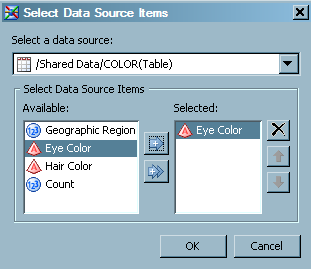 In the sample job, the following column options are set in the Assign columns window:
In the sample job, the following column options are set in the Assign columns window:-
In the Select columns for frequency distribution field, select the values of Eye Color and Hair Color.
-
In the Select columns to obtain separate analysis on each discrete value (BY statement) field, select Geographic Region.
-
In the Select column that represents the frequency of observation (WEIGHT statement) field, select Count.
These fields are shown in the following display:Frequency Column Options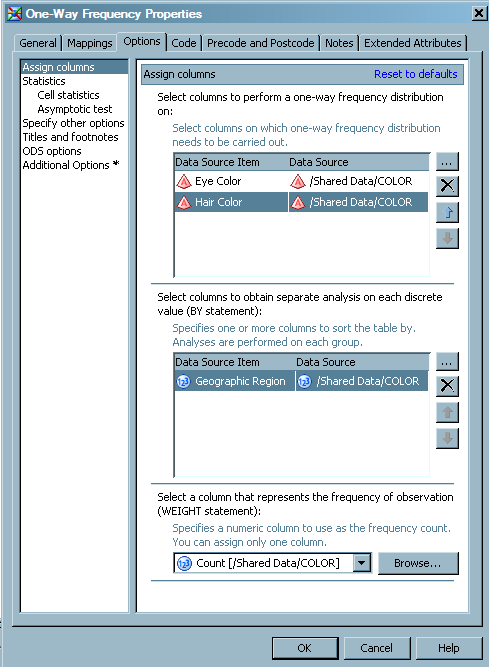
-
-
Set the options for your analysis in the appropriate fields. Note that these frequency options are set for the sample job:
-
In the Specify other options window, enter a value of ORDER=FREQ in the Specify other options for PROC FREQ statement field.
-
In the Specify other options window, select a value of Yes in the Specify number of variables levels (NLEVELS) field.
These fields are shown in the following display:One-Way Frequency Options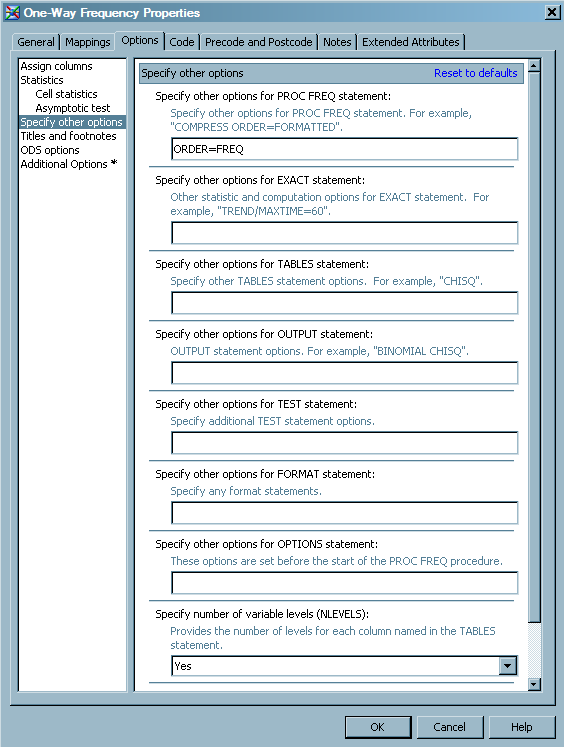
-
Note: In the sample job, the COLOR
source table is already sorted in ascending order according to the
values of the Geographical Region column. The One-Way Frequency transformation
requires sorting by grouping columns. If COLOR is not sorted appropriately,
then a SAS Sort transformation can be added to the job before the
Frequency transformation.
Configure Reporting Options
Use the remaining option pages to create and save a report based on the analysis conducted
in the job. Perform the following steps to set the reporting options:
-
Click Titles and footnotes to access the Titles and footnotes page and enter up to three headings and two footnotes.
-
Click ODS options to access the ODS options page. You can choose between HTML, RTF, and PDF output and enter appropriate settings for each. The sample job uses PDF output. When Use PDF is selected in the ODS result field, new fields are displayed. These include Location, Author, Keywords, Subject, and Additional options for ODS PDF statement. (The path specified in the Location field is relative to the SAS Application Server that executes the job.) These fields are shown in the following display:Sample ODS Options
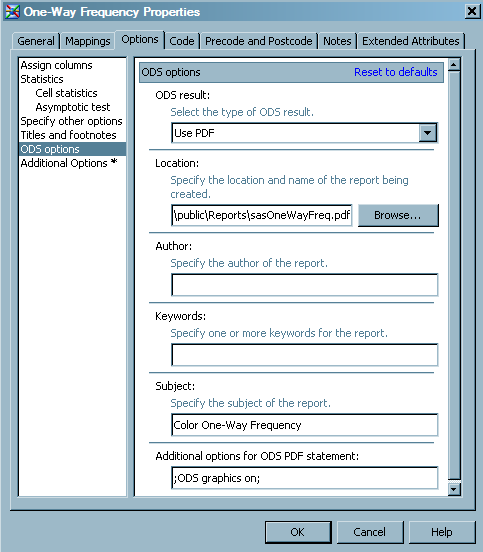
Run the Job and View the Output
Perform the following steps to run the job and view the output:
-
Right-click on an empty area of the job, and click Run in the pop-up menu. SAS Data Integration Studio generates code for the job and submits it to the SAS Application Server for execution. The following display shows a successful run of a sample job:Successfully Completed Sample Job
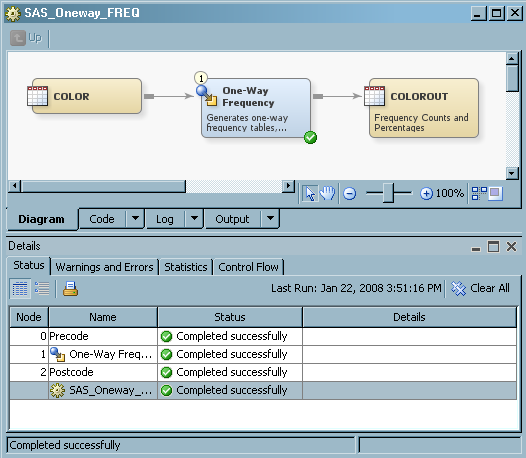
-
If error messages are displayed on the Status tab, read and respond to the messages as needed.
-
To view the frequency analysis, click the Output tab in the Job Editor window. The following display shows the analysis for the sample job:Sample Output in the Output Tab
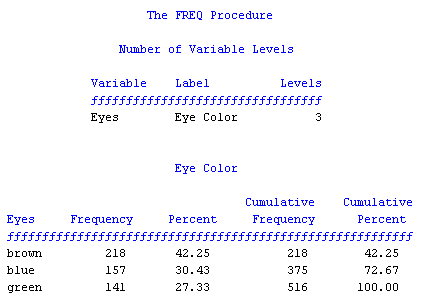
-
To view the target table, right-click the target and select Open. The following display shows the target table data for the sample job:Sample Target Table Data
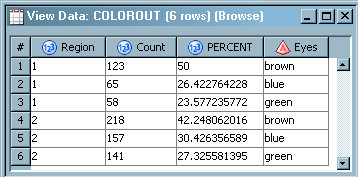
-
Open the PDF document that you created and saved earlier. The following display illustrates a sample report based on the frequency data:Sample PDF Output
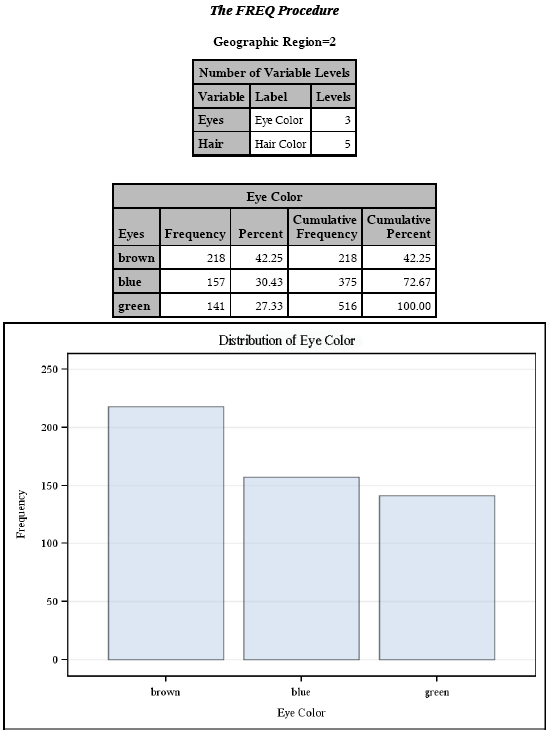
Copyright © SAS Institute Inc. All Rights Reserved.
Last updated: January 16, 2018